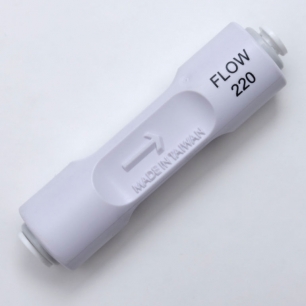The Reverse Osmosis Flow Restrictor

The flow restrictor is located in the yellow drain line of your Black and White reverse osmosis unit. The number indicates its output in mg/L.
The flow restrictor’s function is to regulate the flow of brine, or reject water, leaving the RO membrane housing. It is an essential part of the reverse osmosis process. If the restrictor allows too much water to exit the housing, the RO unit will not produce enough water; too little flow through the restrictor will damage the membrane and lower the quality of the water produced.
The number printed on the restrictor indicates its approximate output in mg/L. Actual output can vary and is influenced by such factors as inlet water pressure, water temperature, and general water quality.
To test the restrictor, turn off the storage tank valve and open and leave open the ledge faucet. When a small stream or fast drip of water is coming from the faucet, it means the unit is making water. Remove the drain line from the undersink drain saddle. There should be a small stream flowing from the drain tube. Catch the stream in a measuring cup that measures milliliters and time for one minute. The output should be more or less the same as the number printed on the restrictor. If the actual output is in the ballpark of the number printed on the restrictor, all is well. If it’s way off, the restrictor should be replaced.
Be sure to replace the restrictor with the size that matches your membrane. See our Reverse Osmosis Parts page for replacement restrictors. Make sure you get the restrictor that matches you membrane size, as explained on the page.




